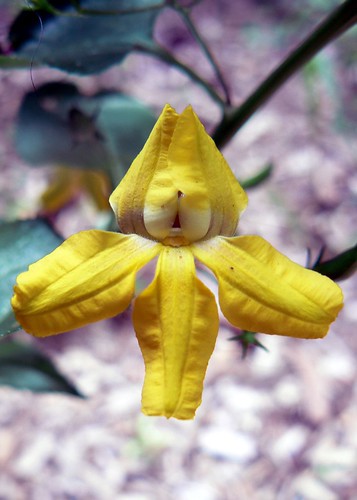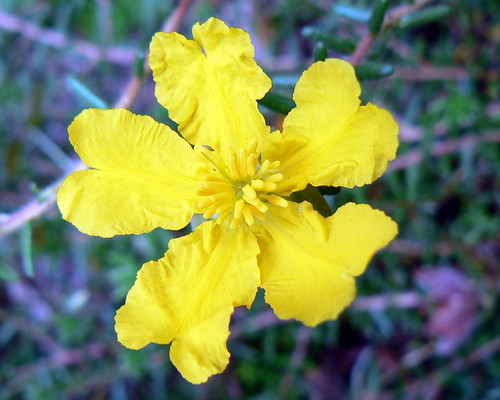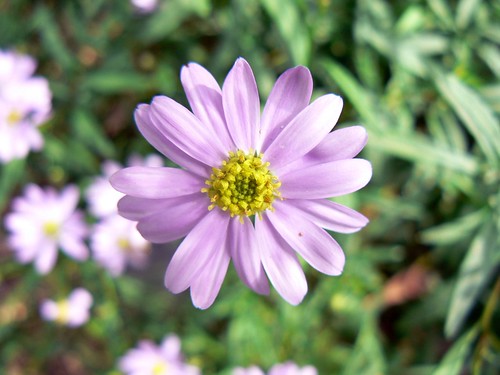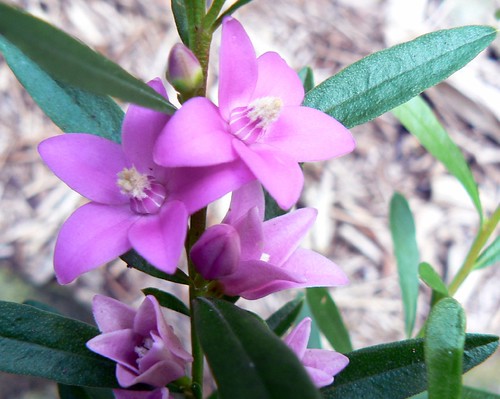The recent rain and summer warmth have coaxed the plants I've cultivated in what were beds full of nasty exotics, into magnificent flower. These are specimens I either grew from cuttings or bought as tubestock. Looks like they're as happy as I am.
So with that, my last post for 2007. Happy new year, everyone! Thanks to those who posted and thanks to all for reading. See you on the other side of the digits. :)
Monday, December 31, 2007
Sunday, December 30, 2007
Food from the Garden.
Today I harvested my potatoes, and got nearly four kilos of Pink Fir Apple and Otway Pink, which isn't bad. The tomatoes, alas, fell victim to possums, so they've ended up in the compost bin. When I build another bed, probably as a no dig patch, I'll try to make it more animal proof.
Instead of more vegies, I've decided to plant this bed out with herbs. I know that the wallabies like eating them, but the fence seems to keep them out. So fingers are crossed!
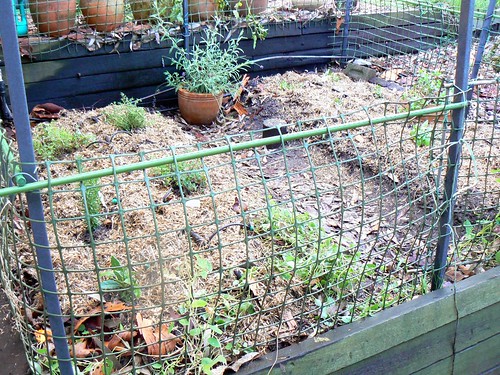
I've planted:
Cooking is something that gives me nearly as much pleasure as gardening, and it'll be great to no longer rely on the green grocer for my herbs. Yum.
Instead of more vegies, I've decided to plant this bed out with herbs. I know that the wallabies like eating them, but the fence seems to keep them out. So fingers are crossed!

I've planted:
- Bay Laurel
- Rosemary
- Basil (three varieties)
- Mint
- Parsley
- Oregano
- Marjoram
- Lemon Grass
- Thyme
- Coriander
- Lavender
- Nasturtium
Cooking is something that gives me nearly as much pleasure as gardening, and it'll be great to no longer rely on the green grocer for my herbs. Yum.
Friday, December 28, 2007
Spring flowers, summer edition.
A few weeks ago, I posted photos of inflorescences of Banksia serrata and Ceratopetalum gummiferum from our garden, with the promise of updated images as they matured.
Here they are:
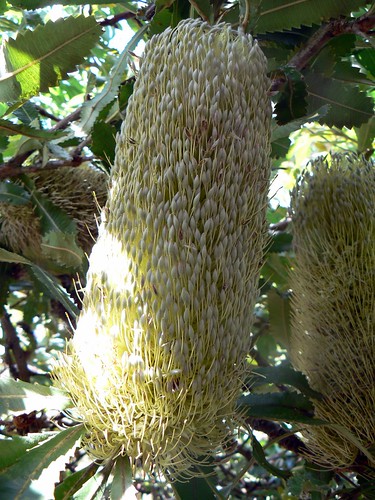 The small flowers within the banksia inflorescences are hugely attractive to local birds, particularly tiny pardalotes and wrens. In a few months, they'll have formed into follicles on the woody axis. They'll eventually open, releasing seed, but that process is much assisted by the heat of bushfire.
The small flowers within the banksia inflorescences are hugely attractive to local birds, particularly tiny pardalotes and wrens. In a few months, they'll have formed into follicles on the woody axis. They'll eventually open, releasing seed, but that process is much assisted by the heat of bushfire.

As you can see from the earlier photo of this plant, the flower has changed from white to red. In fact, the red "petals" are actually the bracts, which remain on the flower well after the petals have gone. The bushland here is dotted these flaming red trees, and are very much a part of a Sydney summer, hence the common name of Ceratopetalum gummiferum, New South Wales Christmas Bush.
Frog update: I've seen some tadpoles in the pond! Don't know what species, but I don't think they're Limnodynastes peronii (which is the frog I heard calling there recently) because its spawn is readily identifiable, floating in a mass on the water surface. I didn't see any spawn at all, which suggests it was submerged. I guess I'll just have to wait till they grow up to find out what they are. Deeply good.
STOP PRESS: The male Brush Turkey (Alectura lathami) who lives near us was just in the back garden, with a mate! I've posted this pic before, but here he is again. Just imagine him now: much the same, but with a big grin on his face. :)
I'll go and visit his mound soon. When she's laid her eggs, she'll bugger off and it'll be his job to tend the mound, maintaining it at the right temperature, till the eggs hatch. Then they're on their own.
Here they are:
 The small flowers within the banksia inflorescences are hugely attractive to local birds, particularly tiny pardalotes and wrens. In a few months, they'll have formed into follicles on the woody axis. They'll eventually open, releasing seed, but that process is much assisted by the heat of bushfire.
The small flowers within the banksia inflorescences are hugely attractive to local birds, particularly tiny pardalotes and wrens. In a few months, they'll have formed into follicles on the woody axis. They'll eventually open, releasing seed, but that process is much assisted by the heat of bushfire.
As you can see from the earlier photo of this plant, the flower has changed from white to red. In fact, the red "petals" are actually the bracts, which remain on the flower well after the petals have gone. The bushland here is dotted these flaming red trees, and are very much a part of a Sydney summer, hence the common name of Ceratopetalum gummiferum, New South Wales Christmas Bush.
Frog update: I've seen some tadpoles in the pond! Don't know what species, but I don't think they're Limnodynastes peronii (which is the frog I heard calling there recently) because its spawn is readily identifiable, floating in a mass on the water surface. I didn't see any spawn at all, which suggests it was submerged. I guess I'll just have to wait till they grow up to find out what they are. Deeply good.
STOP PRESS: The male Brush Turkey (Alectura lathami) who lives near us was just in the back garden, with a mate! I've posted this pic before, but here he is again. Just imagine him now: much the same, but with a big grin on his face. :)
I'll go and visit his mound soon. When she's laid her eggs, she'll bugger off and it'll be his job to tend the mound, maintaining it at the right temperature, till the eggs hatch. Then they're on their own.
Saturday, December 22, 2007
Pearl Beach Field Trip Recce
Yesterday, Louisa and Peta--a couple of my Herbarium colleagues--and I went to Pearl Beach on the NSW Central Coast to check out the place we're staying during the upcoming Plant Science Internship field trip in January. Since I'm going to be cook, I needed to know how well equipped the kitchen is. It's got a big old stove that should happily serve our needs. I just hope my culinary skills do too!
Pearl Beach is a beautiful spot, given to being a holiday house mecca for wealthy celebs, but more interesting for us as an ecologically diverse site for botanising. It's close to coastal heaths, mangrove swamps and temperate rainforest. (Also to leeches, ticks, mosquitoes, sandflies and snakes.... Oh my.)
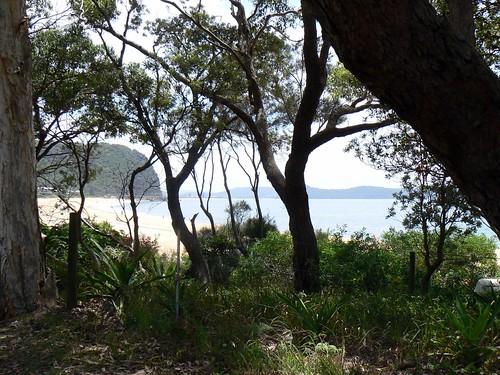
The tree on the left is Melaleuca quinquenervia, Paperbark Teatree, and below, its bark....

This species is typical of the area, growing in coastal swamps and on lake margins on the East Coast of Australia north from Sydney. It's unfortunately become a serious weed in wetlands outside Australia, including in the Florida Everglades, where it grows into huge forests across hundreds of thousands of acres, forming impenetrable monocultures. With the classic irony of the way we screw things up, in some parts of Australia it's becoming quite vulnerable.
Traditionally, Indigenous Australians used the trees for a range of purposes:
And here's a joke, told to me by a plant scientist who is not a molecular biologist:
A molecular biologist was driving through the bush, and came across a farmer herding his sheep along the road. He stopped to let them pass, and got into conversation with the farmer.
"Nice mob of sheep you've got there."
"Yeah. They're good eating."
"Tell you what," said the molecular biologist, "If I can tell you how many sheep you've got, you give me one."
"Okay," said the farmer. "I'm always up for a wager. Go ahead."
"Eighty-six".
"That's pretty good, mate, how'd you work that out?" asked the farmer.
"Oh, in my line of work, you need to be able to quantify things pretty quickly," said the molecular biologist.
"Fair enough," said the farmer. "Help yourself." And the molecular biologist did.
"How about another bet?" said the farmer. "If I guess what your line of work is, you give it back to me."
"All right," said the molecular biologist.
"You're a molecular biologist."
"How'd you know that?" asked the molecular biologist.
"Put down my dog and I'll tell you."
Pearl Beach is a beautiful spot, given to being a holiday house mecca for wealthy celebs, but more interesting for us as an ecologically diverse site for botanising. It's close to coastal heaths, mangrove swamps and temperate rainforest. (Also to leeches, ticks, mosquitoes, sandflies and snakes.... Oh my.)

The tree on the left is Melaleuca quinquenervia, Paperbark Teatree, and below, its bark....

This species is typical of the area, growing in coastal swamps and on lake margins on the East Coast of Australia north from Sydney. It's unfortunately become a serious weed in wetlands outside Australia, including in the Florida Everglades, where it grows into huge forests across hundreds of thousands of acres, forming impenetrable monocultures. With the classic irony of the way we screw things up, in some parts of Australia it's becoming quite vulnerable.
Traditionally, Indigenous Australians used the trees for a range of purposes:
- The bark peels off in strips and has many uses ranging from wrapping food for cooking to making bandages and disposable raincoats. The bark can be used to make containers for food and water storage and for mending holes in canoes.
- A liquid made from the leaves can be used as a wash. The leaves can also be boiled to make a pleasant tea.
- The nectar-rich blossoms can be soaked in water to make a sweet drink.
- All species of melaleuca can be used to treat symptoms of colds, flu and sinusitis by inhaling the steam from boiling or burning the leaves. The young leaves can also be crushed in the hands and released oils inhaled deeply to relive headaches, blocked sinuses, coughs and runny noses. Source: Botanic Gardens, Sydney.
And here's a joke, told to me by a plant scientist who is not a molecular biologist:
A molecular biologist was driving through the bush, and came across a farmer herding his sheep along the road. He stopped to let them pass, and got into conversation with the farmer.
"Nice mob of sheep you've got there."
"Yeah. They're good eating."
"Tell you what," said the molecular biologist, "If I can tell you how many sheep you've got, you give me one."
"Okay," said the farmer. "I'm always up for a wager. Go ahead."
"Eighty-six".
"That's pretty good, mate, how'd you work that out?" asked the farmer.
"Oh, in my line of work, you need to be able to quantify things pretty quickly," said the molecular biologist.
"Fair enough," said the farmer. "Help yourself." And the molecular biologist did.
"How about another bet?" said the farmer. "If I guess what your line of work is, you give it back to me."
"All right," said the molecular biologist.
"You're a molecular biologist."
"How'd you know that?" asked the molecular biologist.
"Put down my dog and I'll tell you."
Wednesday, December 19, 2007
Flannel Flower Gloat Moment
The photo I posted here a while back of the flannel flower (Actinotus helianthi) I'm growing has been chosen for today's Botany Photo of the Day published by UBC Botanical Garden and Centre for Plant Research.
Which is nice.
Just as jolly is that I've sold my first photo. The Herbarium had an art exhibition over recent weeks, "Our Hidden Talents", to which the staff were encouraged to contribute. I entered four photos, and someone liked this one enough to part with ready cash for it. Heck.
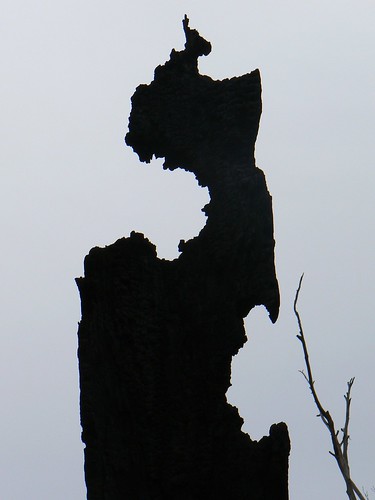
I took this photo, "After the Fire", in February this year, while on the NSW Herbarium Plant Science Internship's field trip to the NSW Central Coast. It's a burnt-out tree in Awaba State Forest.
Which is nice.
Just as jolly is that I've sold my first photo. The Herbarium had an art exhibition over recent weeks, "Our Hidden Talents", to which the staff were encouraged to contribute. I entered four photos, and someone liked this one enough to part with ready cash for it. Heck.

I took this photo, "After the Fire", in February this year, while on the NSW Herbarium Plant Science Internship's field trip to the NSW Central Coast. It's a burnt-out tree in Awaba State Forest.
Saturday, December 01, 2007
Limnodynastes peronii!
Finally, a frog has moved into my pond! It's a Limnodynastes peronii (Striped Marsh Frog) and okay, it's as common as muck, but it's wonderful that finally someone's got the hint.
No photos as yet (I've indeed yet to see him, having only heard his less than dulcet call), but here's a image to go on with (Creative Commons, of course!):
No photos as yet (I've indeed yet to see him, having only heard his less than dulcet call), but here's a image to go on with (Creative Commons, of course!):
